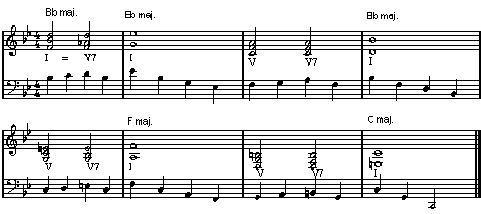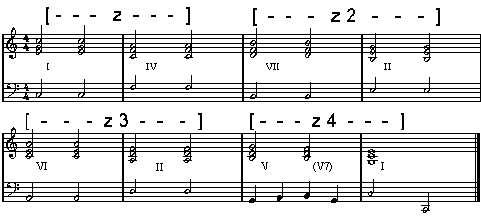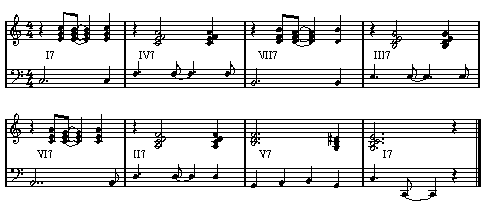What is a Sequence?
A sequence is a musical pattern (sometimes called a musical “figure”) within a piece of music which directly repeats itself (often several times), not at the same pitch (this would be a true repetition), but at a higher or lower step in the scale.
Some examples of sequence
A: MELODIC SEQUENCE
In Example A the musical pattern or figure formed in the first bar (x) is repeated starting one note higher (on D) in the second bar (x2) and repeated one note higher again, starting on E, in the third bar (x3). To bring the melody to a close the fourth bar is different leading back to the keynote C. The sequence used is an ascending sequence.
B: MELODIC SEQUENCE
In Example B there is no sequence in the first two bars. The melodic sequence starts in bar 3. The first four notes of the third bar form part of a descending scale of C in quavers (1/8th notes) (y). This is then repeated starting on different note (A, two notes lower) (y2) and repeated again starting on another different (F, a further two notes lower) (y3). Notice that in y3 there is a small change at the end of the pattern to make the approach to the final note C sound more convincing. Because y3 is not quite the same pattern as y and y2, it is known as a modified sequence. The sequence used is descending and modified.
C: HARMONIC SEQUENCE
Here are the chords which are formed in C major extended over 2 octaves. Example C
In a harmonic sequence the pattern will be formed by changes of chord, rather than of patterns in the melody.
In Example C2 which follows:
- In bars 1 & 2 the chord pattern I to IV forms z. In bars 3 & 4 the chords are now a step lower, VII & III (z2). In bars 5 & 6 they are a further step lower, VI & II (z3). When they appear a step lower still in bars 7 & 8 as V & I (z4), the sequence has gone full cycle and returned to the opening C chord. This harmonic sequence is therefore a descending sequence.
- Notice that z4 is a modified sequence, too: the right hand F turns the V chord into a V7 chord and the bass, too, in bar 7 has more movement than in the earlier sequences.
Note that this same harmonic sequence – particularly with 7ths added to the chords here – is much loved by jazz and rock musicians: Example C3
A similar 8-chord pattern using harmonic sequence is the basis for the repeated harmonies or the ground bass of Pachelbel’s famous Canon. If you have played the bass to Pachelbel’s canon, try building chords over the bass notes to establish the harmonic sequence of the cycle of chords used in the piece. The following links may help you: Easy piano; version for 6 instrumentalists
D: SEQUENCE OF KEY CHANGES (SEQUENTIAL MODULATION)
This is usually defined by a series of V to I progressions. Each time this harmonic pattern recurs a new I chord (and therefore a new key) is reached. The interval formed between the tonic (I) notes of the first and the second figures is maintained when the figure is repeated for a third or fourth time. Example D

In bar 2, Eb major is reached. Two bars later, the key changes back to Bb major – a 4th lower. The next key change is a 4th lower still (to F major two bars later). A final “repeat” of the figure takes us a 4th lower still – to C major at the end. Bars 1, 3, 5 & 7 are all dominant (V) or dominant seventh (V7) chords which lead on to the new tonic (I) chords of the keys reached on each sequential repeat.
Useful Information:
There are two more meanings of the word sequence used in music:
- In computer-recorded music, a sequence is a section of a track of music in an electronically created composition. The most recent definition! Hence the term “sequencer” for a software package which allows you to record and edit musically on a computer.
- In medieval church music the Alleluia of the Mass (sung in plainsong) was often elaborated with many extra notes to express the joy of the word “Alleluia”. In the course of time musicians added extra text to these extra notes and so new plainchants came into being. These were called sequences because they followed on from (or developed out of) the original alleluias. For the past 4 centuries only four genuine medieval sequences have continued to be used in the Catholic Church: Victimae paschali at Easter, Veni, sancte spiritus at Whitsun, Lauda Sion at the Feast of Corpus Christi and Dies Irae for Requiems or Funerals.





